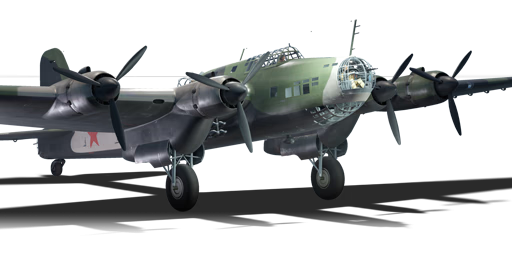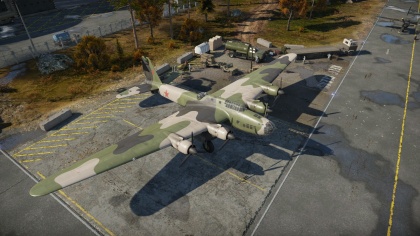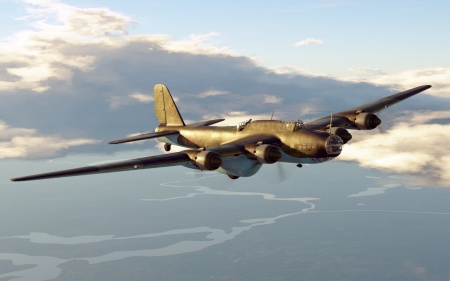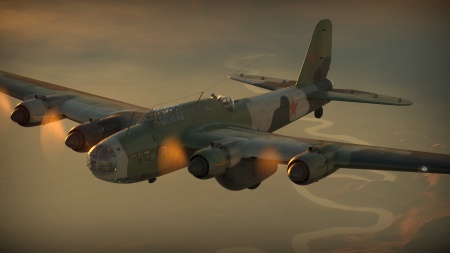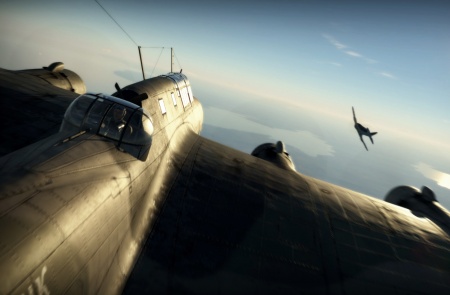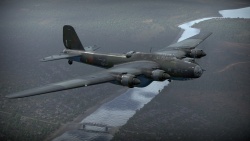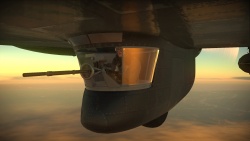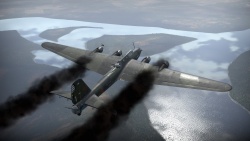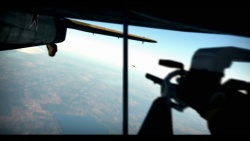Difference between revisions of "Pe-8"
(Edits) |
|||
| Line 2: | Line 2: | ||
== Description == | == Description == | ||
| − | <!--''In the description, the first part | + | <!-- ''In the description, the first part should be about the history of and the creation and combat usage of the aircraft, as well as its key features. In the second part, tell the reader about the aircraft in the game. Insert a screenshot of the vehicle, so that if the novice player does not remember the vehicle by name, he will immediately understand what kind of vehicle the article is talking about.'' --> |
| − | |||
[[File:GarageImage_{{PAGENAME}}.jpg|420px|thumb|left]] | [[File:GarageImage_{{PAGENAME}}.jpg|420px|thumb|left]] | ||
| − | {{ | + | {{Break}} |
| − | The '''{{Specs|name}}''' is a rank {{Specs|rank}} Soviet heavy bomber {{Battle-rating}}. It was introduced in [[Update 1.53 "Firestorm"]]. | + | The '''{{Specs|name}}''' is a rank {{Specs|rank}} Soviet heavy bomber {{Battle-rating}}. It was introduced in [[Update 1.53 "Firestorm"]]. |
| − | The Petlyakov {{PAGENAME}} was an early design Soviet heavy bomber which debuted in 1936. This monster of a bomber was the only four-engine bomber produced by the Soviet Union during World War II. Though impressive as it was, it was only produced in limited numbers and was reserved for special occasions called | + | The Petlyakov {{PAGENAME}} was an early design Soviet heavy bomber which debuted in 1936. This monster of a bomber was the only four-engine bomber produced by the Soviet Union during World War II. Though impressive as it was, it was only produced in limited numbers and was reserved for special occasions called "morale raids" to encourage and raise the spirits of the Soviet population by hitting important German targets deep behind enemy lines to include bombing Berlin in mid-1941. Other prime targets included the nighttime bombing of factories, German airfields and rail yards. As such an important aircraft to the Soviet people, it became a priority target for the German Luftwaffe pilots to go after. By 1944 all remaining {{PAGENAME}}s were removed from service but were retrofitted for other jobs such as VIP transport and operations up into the arctic circle. |
| − | The {{PAGENAME}} though a large and tempting target, it is not without its merits. The huge bomber has a nose gunner, tail gunner, rear-facing dorsal turret and two rear-facing underwing gun pods. Attacking this aircraft especially from the rear whether above, below or directly from the rear is a bad choice as, like with the [[BV 238]], there are many defensive guns which can hit and hit hard. These defensive weapons are critical to protecting the bomber against inbound enemy fighter especially because of the bomb payload which it can carry. Options can range between 2,000 and 5,000 kg bomb loads with as many as 40 x 50 kg or 100 kg bombs, or fewer but heavier bombs such as 6 x 500 kg bombs or a single massive 5,000 kg FAB-5000 bomb. | + | The {{PAGENAME}} though a large and tempting target, it is not without its merits. The huge bomber has a nose gunner, tail gunner, rear-facing dorsal turret and two rear-facing underwing gun pods. Attacking this aircraft especially from the rear whether above, below or directly from the rear is a bad choice as, like with the [[BV 238]], there are many defensive guns which can hit and hit hard. These defensive weapons are critical to protecting the bomber against inbound enemy fighter especially because of the bomb payload which it can carry. Options can range between 2,000 and 5,000 kg bomb loads with as many as 40 x 50 kg or 100 kg bombs, or fewer but heavier bombs such as 6 x 500 kg bombs or a single massive 5,000 kg FAB-5000 bomb. |
It is easy to see why the {{PAGENAME}} would be a prime target to eliminate as if left unchecked, it could easily wipe out the enemy bases without flinching and move onto the next. Other payload options are useful for carpet bombing areas where clusters of lighter vehicles or fixed anti-aircraft targets may sit. Fleet vessels are not to discount this bomber as it has the means to destroy ships with its accurate bomb site, pending the pilot slowing the aircraft down enough to let the bombardier line up the target and release the necessary ordnance. For the pilot of the {{PAGENAME}}, fly high and drop as much as you can on the targets, as a fighter trying to take out the {{PAGENAME}} set up your run so that in the event you lose control of your aircraft, it has a good chance of ramming the bomber causing it to crash as this aircraft has a good propensity to soak up bullets. | It is easy to see why the {{PAGENAME}} would be a prime target to eliminate as if left unchecked, it could easily wipe out the enemy bases without flinching and move onto the next. Other payload options are useful for carpet bombing areas where clusters of lighter vehicles or fixed anti-aircraft targets may sit. Fleet vessels are not to discount this bomber as it has the means to destroy ships with its accurate bomb site, pending the pilot slowing the aircraft down enough to let the bombardier line up the target and release the necessary ordnance. For the pilot of the {{PAGENAME}}, fly high and drop as much as you can on the targets, as a fighter trying to take out the {{PAGENAME}} set up your run so that in the event you lose control of your aircraft, it has a good chance of ramming the bomber causing it to crash as this aircraft has a good propensity to soak up bullets. | ||
== General info == | == General info == | ||
| − | === Flight | + | === Flight performance === |
| − | <!--''Describe how the aircraft behaves in the air. | + | <!-- ''Describe how the aircraft behaves in the air. Speed, manoeuvrability, acceleration and allowable loads - these are the most important characteristics of the vehicle.'' --> |
[[File:Pe-8 lunarrainbow 001.jpg|450px|thumb|right|]] | [[File:Pe-8 lunarrainbow 001.jpg|450px|thumb|right|]] | ||
| − | {| class="wikitable" style="text-align:center" | + | |
| − | + | {| class="wikitable" style="text-align:center" width="70%" | |
| − | + | ! rowspan="2" | Characteristics | |
| − | |||
| − | ! | ||
| − | |||
! colspan="2" | Max Speed<br>(km/h at 5,900 m) | ! colspan="2" | Max Speed<br>(km/h at 5,900 m) | ||
| − | ! rowspan="2" | Max altitude<br>( | + | ! rowspan="2" | Max altitude<br>(metres) |
! colspan="2" | Turn time<br>(seconds) | ! colspan="2" | Turn time<br>(seconds) | ||
| − | ! colspan="2" | Rate of climb<br>( | + | ! colspan="2" | Rate of climb<br>(metres/second) |
| − | ! rowspan="2" |Take-off run<br>( | + | ! rowspan="2" | Take-off run<br>(metres) |
| − | |||
| − | |||
| − | |||
| − | |||
| − | |||
| − | |||
| − | |||
| − | |||
| − | |||
| − | |||
| − | |||
|- | |- | ||
| − | ! | + | ! AB !! RB !! AB !! RB !! AB !! RB |
| − | ! | ||
| − | ! | ||
| − | ! | ||
| − | ! | ||
|- | |- | ||
| − | ! | + | ! Stock |
| − | + | | 402 || 387 || rowspan="2" | {{Specs|ceiling}} || 36.9 || 37.6 || 4.9 || 4.9 || rowspan="2" | 1,500 | |
| − | |||
| − | |||
| − | |||
| − | |||
|- | |- | ||
| − | |445||422 | + | ! Upgraded |
| + | | 445 || 422 || 35.1 || 36.0 || 10.2 || 7.2 | ||
|- | |- | ||
|} | |} | ||
| − | ====Details==== | + | ==== Details ==== |
| − | {| class="wikitable" style="text-align:center" | + | {| class="wikitable" style="text-align:center" width="50%" |
|- | |- | ||
! colspan="5" | Features | ! colspan="5" | Features | ||
|- | |- | ||
| − | ! Combat | + | ! Combat flaps !! Take-off flaps !! Landing flaps !! Air brakes !! Arrestor gear |
| − | ! Take-off | ||
| − | ! Landing | ||
| − | ! Air brakes | ||
| − | ! Arrestor gear | ||
|- | |- | ||
| − | | ✓|| ✓ || ✓ || X || X | + | | ✓ || ✓ || ✓ || X || X <!-- ✓ --> |
|- | |- | ||
|} | |} | ||
| − | {| class="wikitable" style="text-align:center" | + | {| class="wikitable" style="text-align:center" width="50%" |
|- | |- | ||
| − | ! colspan=" | + | ! colspan="7" | Limits |
|- | |- | ||
| − | ! rowspan="2" | | + | ! rowspan="2" | Wings (km/h) |
| − | ! rowspan="2" | Gear | + | ! rowspan="2" | Gear (km/h) |
| − | ! | + | ! colspan="3" | Flaps (km/h) |
! colspan="2" | Max Static G | ! colspan="2" | Max Static G | ||
|- | |- | ||
| − | ! + | + | ! Combat !! Take-off !! Landing !! + !! - |
| − | ! - | ||
|- | |- | ||
| − | | | + | | {{Specs|destruction|body}} || {{Specs|destruction|gear}} || 480 || 380 || 280 || ~3 || ~3 |
|- | |- | ||
|} | |} | ||
| Line 91: | Line 64: | ||
{| class="wikitable" style="text-align:center" | {| class="wikitable" style="text-align:center" | ||
|- | |- | ||
| − | ! colspan="4" | Optimal velocities | + | ! colspan="4" | Optimal velocities (km/h) |
|- | |- | ||
| − | ! Ailerons | + | ! Ailerons !! Rudder !! Elevators !! Radiator |
| − | ! Rudder | ||
| − | ! Elevators | ||
| − | ! Radiator | ||
|- | |- | ||
| − | | | + | | < 320 || < 350 || < 380 || > 341 |
|- | |- | ||
|} | |} | ||
| Line 112: | Line 82: | ||
! WEP Engine power | ! WEP Engine power | ||
|- | |- | ||
| − | | 2,050 m || 6,160 hp || 7,478 hp | + | | 2,050 m || 6,160 hp || 7,478 hp |
|- | |- | ||
| − | + | ! colspan="3" | Setting 2 | |
|- | |- | ||
! Optimal altitude | ! Optimal altitude | ||
| Line 120: | Line 90: | ||
! WEP Engine power | ! WEP Engine power | ||
|- | |- | ||
| − | | 5,400 m || 5,200 hp || | + | | 5,400 m || 5,200 hp || N/A |
| − | |||
| − | |||
| − | |||
| − | |||
| − | |||
| − | |||
|- | |- | ||
| − | |||
| − | |||
|} | |} | ||
=== Survivability and armour === | === Survivability and armour === | ||
| − | <!--''Examine the survivability of the aircraft. Note how vulnerable the structure is and how secure the pilot is, whether the fuel tanks are armoured. Describe the armour, if there is any, also mention the vulnerability of other critical aircraft systems.''--> | + | <!-- ''Examine the survivability of the aircraft. Note how vulnerable the structure is and how secure the pilot is, whether the fuel tanks are armoured, etc. Describe the armour, if there is any, and also mention the vulnerability of other critical aircraft systems.'' --> |
* 8 mm Steel - Plate behind pilot's seat | * 8 mm Steel - Plate behind pilot's seat | ||
| Line 145: | Line 107: | ||
[[File:Pe-8 *jermster 91 001.jpg|450px|thumb|right|]] | [[File:Pe-8 *jermster 91 001.jpg|450px|thumb|right|]] | ||
=== Suspended armament === | === Suspended armament === | ||
| − | <!--''Describe the aircraft's suspended armament: additional cannons under the wings, bombs, rockets and torpedoes. This section is especially important for bombers and attackers. If there is no suspended weaponry remove this subsection.''--> | + | <!-- ''Describe the aircraft's suspended armament: additional cannons under the wings, bombs, rockets and torpedoes. This section is especially important for bombers and attackers. If there is no suspended weaponry remove this subsection.'' --> |
{{main|FAB-50 (50 kg)|FAB-100 (100 kg)|FAB-250M43 (250 kg)|FAB-500 (500 kg)|FAB-1000 (1,000 kg)}} | {{main|FAB-50 (50 kg)|FAB-100 (100 kg)|FAB-250M43 (250 kg)|FAB-500 (500 kg)|FAB-1000 (1,000 kg)}} | ||
{{main|FAB-5000 (5,000 kg)}} | {{main|FAB-5000 (5,000 kg)}} | ||
| − | The '''''{{PAGENAME}}''''' can be outfitted with | + | The '''''{{PAGENAME}}''''' can be outfitted with the following ordnance: |
* 40 x 50 kg FAB-50 bombs (2,000 kg total) | * 40 x 50 kg FAB-50 bombs (2,000 kg total) | ||
| − | * 40 x 100 kg FAB-100 | + | * 40 x 100 kg FAB-100 bombs (4,000 kg total) |
* 12 x 250 kg FAB-250M43 bombs (3,000 kg total) | * 12 x 250 kg FAB-250M43 bombs (3,000 kg total) | ||
| − | * 6 x 500 kg FAB-500 | + | * 6 x 500 kg FAB-500 bombs (3,000 kg total) |
| − | * 4 x 1,000 kg FAB-1000 bombs | + | * 4 x 1,000 kg FAB-1000 bombs (4,000 kg total) |
* 1 x 5,000 kg FAB-5000 bomb (5,000 kg total) | * 1 x 5,000 kg FAB-5000 bomb (5,000 kg total) | ||
=== Defensive armament === | === Defensive armament === | ||
| − | <!--''Defensive armament with turret machine guns or cannons, crewed by gunners. Examine the number of gunners and what belts or drums are better to use. If defensive weaponry is not available remove this subsection.''--> | + | <!-- ''Defensive armament with turret machine guns or cannons, crewed by gunners. Examine the number of gunners and what belts or drums are better to use. If defensive weaponry is not available, remove this subsection.'' --> |
| − | {{main| | + | {{main|ShVAK (20 mm)|Berezin UB (12.7 mm)|ShKAS (7.62 mm)}} |
The '''''{{PAGENAME}}''''' is defended by: | The '''''{{PAGENAME}}''''' is defended by: | ||
| − | |||
| − | |||
* 1 x 20 mm ShVAK cannon, dorsal turret (200 rpg) | * 1 x 20 mm ShVAK cannon, dorsal turret (200 rpg) | ||
* 1 x 20 mm ShVAK cannon, tail turret (230 rpg) | * 1 x 20 mm ShVAK cannon, tail turret (230 rpg) | ||
| + | * 1 x 12.7 mm Berezin UB machine gun, 2 x engine nacelle turrets (200 rpg) | ||
| + | * 2 x 7.62 mm ShKAS machine guns, nose turret (750 rpg = 1,500 total) | ||
| − | == Usage in | + | == Usage in battles == |
| − | <!--''Describe the tactics of playing in | + | <!-- ''Describe the tactics of playing in the aircraft, the features of using aircraft in a team and advice on tactics. Refrain from creating a "guide" - do not impose a single point of view, but instead, give the reader food for thought. Examine the most dangerous enemies and give recommendations on fighting them. If necessary, note the specifics of the game in different modes (AB, RB, SB).'' --> |
[[File:Pe-8 the interceptor 002.jpg|450px|thumb|right|]] | [[File:Pe-8 the interceptor 002.jpg|450px|thumb|right|]] | ||
| − | The Pe-8, as mentioned earlier, is in essence a Russian Death Star (a.k.a Tu-4 at a lower tier). It both boasts a very effective cannon armament and a high bomb load, able to kill two bases in one pass. It's 5,000-kilo bomb is especially useful in Ground Battles as a "tactical nuke" of sorts, able to wipe out large concentrations of enemy tanks. | + | The Pe-8, as mentioned earlier, is in essence a Russian Death Star (a.k.a Tu-4 at a lower tier). It both boasts a very effective cannon armament and a high bomb load, able to kill two bases in one pass. It's 5,000-kilo bomb is especially useful in Ground Battles as a "tactical nuke" of sorts, able to wipe out large concentrations of enemy tanks. |
However, the FAB-5000's practicality ends there. In Air Battles, the FAB-5000 is woefully overpowered against most targets and makes it inferior to most of the plane's other bomb combinations. In addition, it peculiarly does less damage against an airfield than the 4 x 1,000 kg payload, further decreasing its usefulness. Instead, use the other payloads. The stock payload of 40 x 100 kg bombs, while difficult to aim, can still be used to base bomb, simply drop 12 on a base to destroy it (remember that the first 16 are pylon mounted meaning they drop in pairs, so the first base will require only 6 presses of the bomb release button). Keep using this payload for base bombing until you unlock the 4 x 1,000 kg modification, as all the other payloads yield less damage. You can use your bombs to destroy ground targets as well, however, be sure to be high enough or use a timer so that the bomb's splash damage doesn't kill you. | However, the FAB-5000's practicality ends there. In Air Battles, the FAB-5000 is woefully overpowered against most targets and makes it inferior to most of the plane's other bomb combinations. In addition, it peculiarly does less damage against an airfield than the 4 x 1,000 kg payload, further decreasing its usefulness. Instead, use the other payloads. The stock payload of 40 x 100 kg bombs, while difficult to aim, can still be used to base bomb, simply drop 12 on a base to destroy it (remember that the first 16 are pylon mounted meaning they drop in pairs, so the first base will require only 6 presses of the bomb release button). Keep using this payload for base bombing until you unlock the 4 x 1,000 kg modification, as all the other payloads yield less damage. You can use your bombs to destroy ground targets as well, however, be sure to be high enough or use a timer so that the bomb's splash damage doesn't kill you. | ||
| − | Try to side climb around the main battle when going after bases, though your defensive armament is powerful, you will be an easy target for experienced players, heavy fighters, and groups of fighters that encounter you. If you see an enemy, always turn the plane to make sure the rear cannon-armed guns face the pursuer so you can focus as much of your defensive firepower on them as possible while also increasing the time you can put your guns on the target. Make sure to fire in bursts as your guns will jam if fired for too long. | + | Try to side climb around the main battle when going after bases, though your defensive armament is powerful, you will be an easy target for experienced players, heavy fighters, and groups of fighters that encounter you. If you see an enemy, always turn the plane to make sure the rear cannon-armed guns face the pursuer so you can focus as much of your defensive firepower on them as possible while also increasing the time you can put your guns on the target. Make sure to fire in bursts as your guns will jam if fired for too long. |
| − | In Ground Realistic mode, the Pe-8 can be used to devastating effect as a "meme" CAS aircraft. If there are no fighter aircraft or few SPAA, try to find the largest group of enemies and drop the FAB-5000 as fast as you can. This usually results in 1-2 kills, but can easily net many more. Try to spawn early game, as there will be less fighter aircraft and SPAA. Let it be noted that there is a certain terror from seeing a FAB-5000 land next to your tank that is not easily replicated elsewhere in War Thunder. | + | In Ground Realistic mode, the Pe-8 can be used to devastating effect as a "meme" CAS aircraft. If there are no fighter aircraft or few SPAA, try to find the largest group of enemies and drop the FAB-5000 as fast as you can. This usually results in 1-2 kills, but can easily net many more. Try to spawn early game, as there will be less fighter aircraft and SPAA. Let it be noted that there is a certain terror from seeing a FAB-5000 land next to your tank that is not easily replicated elsewhere in War Thunder. |
| − | In Naval Battles, the Pe-8 can be used to break up large groups of ships, however it is difficult to do so, as the AA fire in Naval battles is much more accurate, hard-hitting, and plentiful. One would try to compensate for this by flying high up, but you will find that it is hard to aim the FAB-5000 from these altitudes. Thus, it is more effective to bring the Pe-8 to higher tier battles with less-maneuverable, usually slower ships. | + | In Naval Battles, the Pe-8 can be used to break up large groups of ships, however it is difficult to do so, as the AA fire in Naval battles is much more accurate, hard-hitting, and plentiful. One would try to compensate for this by flying high up, but you will find that it is hard to aim the FAB-5000 from these altitudes. Thus, it is more effective to bring the Pe-8 to higher tier battles with less-maneuverable, usually slower ships. |
====Counter-tactics==== | ====Counter-tactics==== | ||
| Line 187: | Line 149: | ||
When pursuing the Pe-8, try to go for a head-on - nearly all the time there is critical damage and "pilot snipes" to down the aircraft - with the added bonus that the front is the least defended area of the Pe-8. Use your mobility to do so. When in a not so optimal position, try to come up at a angle above the Pe-8 - with a sharp enough angle, you will stop the 12.7's from reaching you, and with a bit of luck, you will make it past the single 20 defending the plane. | When pursuing the Pe-8, try to go for a head-on - nearly all the time there is critical damage and "pilot snipes" to down the aircraft - with the added bonus that the front is the least defended area of the Pe-8. Use your mobility to do so. When in a not so optimal position, try to come up at a angle above the Pe-8 - with a sharp enough angle, you will stop the 12.7's from reaching you, and with a bit of luck, you will make it past the single 20 defending the plane. | ||
| − | + | === Manual Engine Control === | |
| − | ===Manual Engine Control=== | ||
{| class="wikitable" style="text-align:center" | {| class="wikitable" style="text-align:center" | ||
|- | |- | ||
! colspan="7" | MEC elements | ! colspan="7" | MEC elements | ||
|- | |- | ||
| − | ! rowspan="2" |Mixer | + | ! rowspan="2" | Mixer |
| − | ! rowspan="2" |Pitch | + | ! rowspan="2" | Pitch |
| − | ! colspan="3" |Radiator | + | ! colspan="3" | Radiator |
| − | ! rowspan="2" |Supercharger | + | ! rowspan="2" | Supercharger |
| − | ! rowspan="2" |Turbocharger | + | ! rowspan="2" | Turbocharger |
|- | |- | ||
| − | ! Oil | + | ! Oil !! Water !! Type |
| − | ! Water | ||
| − | ! Type | ||
|- | |- | ||
| − | | Controllable || | + | | Controllable || Controllable<br>Not auto controlled || Controllable<br>Auto control available || Controllable<br>Auto control available || Separate || Controllable<br>2 gears || Not controllable |
|- | |- | ||
|} | |} | ||
| − | ===Modules=== | + | === Modules === |
{| class="wikitable" | {| class="wikitable" | ||
| − | ! | + | ! Tier |
! colspan="2" | Flight performance | ! colspan="2" | Flight performance | ||
| − | ! | + | ! Survivability |
! colspan="3" | Weaponry | ! colspan="3" | Weaponry | ||
|- | |- | ||
| I | | I | ||
| − | | Fuselage | + | | Fuselage repair |
| Radiator | | Radiator | ||
| − | | | + | | |
| Turret 12 mm | | Turret 12 mm | ||
| − | | | + | | |
| Der-13P | | Der-13P | ||
|- | |- | ||
| II | | II | ||
| − | | | + | | |
| Compressor | | Compressor | ||
| Airframe | | Airframe | ||
| New 12 mm MGs (turret) | | New 12 mm MGs (turret) | ||
| − | | | + | | |
| Der-19P | | Der-19P | ||
|- | |- | ||
| III | | III | ||
| − | | Wings | + | | Wings repair |
| Engine | | Engine | ||
| − | | | + | | |
| Turret 7 mm | | Turret 7 mm | ||
| − | | Turret | + | | Turret 20 mm |
| Der-20P | | Der-20P | ||
|- | |- | ||
| IV | | IV | ||
| − | | | + | | |
| − | | Engine | + | | Engine injection |
| Cover | | Cover | ||
| New 7 mm MGs (turret) | | New 7 mm MGs (turret) | ||
| − | | New | + | | New 20 mm cannons (turret) |
| Der-20U | | Der-20U | ||
|- | |- | ||
| Line 249: | Line 208: | ||
=== Pros and cons === | === Pros and cons === | ||
| − | <!--'' | + | <!-- ''Summarise and briefly evaluate the vehicle in terms of its characteristics and combat effectiveness. Mark its pros and cons in the bulleted list. Try not to use more than 6 points for each of the characteristics. Avoid using categorical definitions such as "bad", "good" and the like - use substitutions with softer forms such as "inadequate" and "effective".'' --> |
[[File:Pe-8 the interceptor 001.jpg|450px|thumb|right|Inbound bogie as seen by the nose gunner somewhere over the Eastern Front.]] | [[File:Pe-8 the interceptor 001.jpg|450px|thumb|right|Inbound bogie as seen by the nose gunner somewhere over the Eastern Front.]] | ||
| + | |||
'''Pros:''' | '''Pros:''' | ||
| Line 258: | Line 218: | ||
* Durable airframe - can take some damage and make it home | * Durable airframe - can take some damage and make it home | ||
* Can resist being up-tiered for a while; possible to bring in tier IV matches | * Can resist being up-tiered for a while; possible to bring in tier IV matches | ||
| − | * A big step up from the [[Yer-2_M-105|Yer-2]]'s ShKAS | + | * A big step up from the [[Yer-2_M-105|Yer-2]]'s ShKAS |
* Matchmaking can be gracious | * Matchmaking can be gracious | ||
* Decent Silver Lions and Research Points earner | * Decent Silver Lions and Research Points earner | ||
| Line 275: | Line 235: | ||
== History == | == History == | ||
| − | ''Describe the history of the creation and combat usage of the aircraft in more detail than in the introduction. If the historical reference turns out to be too | + | ''Describe the history of the creation and combat usage of the aircraft in more detail than in the introduction. If the historical reference turns out to be too long, take it to a separate article, taking a link to the article about the vehicle and adding a block "/History" (example: <nowiki>https://wiki.warthunder.com/(Vehicle-name)/History</nowiki>) and add a link to it here using the <code>main</code> template. Be sure to reference text and sources by using <code><nowiki><ref></ref></nowiki></code>, as well as adding them at the end of the article with <code><nowiki><references /></nowiki></code>. This section may also include the vehicle's dev blog entry (if applicable) and the in-game encyclopedia description (under <code><nowiki>=== In-game description ===</nowiki></code>, also if applicable).'' |
== Media == | == Media == | ||
| − | <!--'' | + | <!-- ''Excellent additions to the article would be video guides, screenshots from the game, and photos.'' --> |
;Images | ;Images | ||
| Line 288: | Line 248: | ||
</ul></div> | </ul></div> | ||
| − | == | + | == See also == |
| − | <!--''Links to the articles on the War Thunder Wiki that you think will be useful for the reader, for example | + | <!-- ''Links to the articles on the War Thunder Wiki that you think will be useful for the reader, for example:'' |
| − | |||
* ''reference to the series of the aircraft;'' | * ''reference to the series of the aircraft;'' | ||
| − | * ''links to approximate analogues of other nations and research trees.''--> | + | * ''links to approximate analogues of other nations and research trees.'' --> |
;Aircraft of comparable role, configuration and era | ;Aircraft of comparable role, configuration and era | ||
| Line 304: | Line 263: | ||
* Short [[Stirling B Mk I|Stirling]] | * Short [[Stirling B Mk I|Stirling]] | ||
| − | == | + | == External links == |
''Paste links to sources and external resources, such as:'' | ''Paste links to sources and external resources, such as:'' | ||
| − | |||
* ''topic on the official game forum;'' | * ''topic on the official game forum;'' | ||
| − | * ''page on aircraft | + | * ''encyclopedia page on the aircraft;'' |
* ''other literature.'' | * ''other literature.'' | ||
| − | {{ | + | {{AirManufacturer Petlyakov}} |
{{USSR bombers}} | {{USSR bombers}} | ||
Revision as of 20:30, 29 August 2020
Contents
Description
The Pe-8 is a rank III Soviet heavy bomber
with a battle rating of 4.3 (AB/RB) and 5.3 (SB). It was introduced in Update 1.53 "Firestorm".
The Petlyakov Pe-8 was an early design Soviet heavy bomber which debuted in 1936. This monster of a bomber was the only four-engine bomber produced by the Soviet Union during World War II. Though impressive as it was, it was only produced in limited numbers and was reserved for special occasions called "morale raids" to encourage and raise the spirits of the Soviet population by hitting important German targets deep behind enemy lines to include bombing Berlin in mid-1941. Other prime targets included the nighttime bombing of factories, German airfields and rail yards. As such an important aircraft to the Soviet people, it became a priority target for the German Luftwaffe pilots to go after. By 1944 all remaining Pe-8s were removed from service but were retrofitted for other jobs such as VIP transport and operations up into the arctic circle.
The Pe-8 though a large and tempting target, it is not without its merits. The huge bomber has a nose gunner, tail gunner, rear-facing dorsal turret and two rear-facing underwing gun pods. Attacking this aircraft especially from the rear whether above, below or directly from the rear is a bad choice as, like with the BV 238, there are many defensive guns which can hit and hit hard. These defensive weapons are critical to protecting the bomber against inbound enemy fighter especially because of the bomb payload which it can carry. Options can range between 2,000 and 5,000 kg bomb loads with as many as 40 x 50 kg or 100 kg bombs, or fewer but heavier bombs such as 6 x 500 kg bombs or a single massive 5,000 kg FAB-5000 bomb.
It is easy to see why the Pe-8 would be a prime target to eliminate as if left unchecked, it could easily wipe out the enemy bases without flinching and move onto the next. Other payload options are useful for carpet bombing areas where clusters of lighter vehicles or fixed anti-aircraft targets may sit. Fleet vessels are not to discount this bomber as it has the means to destroy ships with its accurate bomb site, pending the pilot slowing the aircraft down enough to let the bombardier line up the target and release the necessary ordnance. For the pilot of the Pe-8, fly high and drop as much as you can on the targets, as a fighter trying to take out the Pe-8 set up your run so that in the event you lose control of your aircraft, it has a good chance of ramming the bomber causing it to crash as this aircraft has a good propensity to soak up bullets.
General info
Flight performance
| Characteristics | Max Speed (km/h at 5,900 m) |
Max altitude (metres) |
Turn time (seconds) |
Rate of climb (metres/second) |
Take-off run (metres) | |||
|---|---|---|---|---|---|---|---|---|
| AB | RB | AB | RB | AB | RB | |||
| Stock | 402 | 387 | 10500 | 36.9 | 37.6 | 4.9 | 4.9 | 1,500 |
| Upgraded | 445 | 422 | 35.1 | 36.0 | 10.2 | 7.2 | ||
Details
| Features | ||||
|---|---|---|---|---|
| Combat flaps | Take-off flaps | Landing flaps | Air brakes | Arrestor gear |
| ✓ | ✓ | ✓ | X | X |
| Limits | ||||||
|---|---|---|---|---|---|---|
| Wings (km/h) | Gear (km/h) | Flaps (km/h) | Max Static G | |||
| Combat | Take-off | Landing | + | - | ||
| 0 | 390 | 480 | 380 | 280 | ~3 | ~3 |
| Optimal velocities (km/h) | |||
|---|---|---|---|
| Ailerons | Rudder | Elevators | Radiator |
| < 320 | < 350 | < 380 | > 341 |
| Compressor (RB/SB) | ||
|---|---|---|
| Setting 1 | ||
| Optimal altitude | 100% Engine power | WEP Engine power |
| 2,050 m | 6,160 hp | 7,478 hp |
| Setting 2 | ||
| Optimal altitude | 100% Engine power | WEP Engine power |
| 5,400 m | 5,200 hp | N/A |
Survivability and armour
- 8 mm Steel - Plate behind pilot's seat
- 8 mm Steel - Plate behind copilot's seat
- 8 mm Steel - Plate for underwing nacelle gunners x 2
- No armour glazing
- Critical components located in front of aircraft (fuel, pilot, engine, controls)
- More fuel tanks located in throughout wings
Armaments
Suspended armament
The Pe-8 can be outfitted with the following ordnance:
- 40 x 50 kg FAB-50 bombs (2,000 kg total)
- 40 x 100 kg FAB-100 bombs (4,000 kg total)
- 12 x 250 kg FAB-250M43 bombs (3,000 kg total)
- 6 x 500 kg FAB-500 bombs (3,000 kg total)
- 4 x 1,000 kg FAB-1000 bombs (4,000 kg total)
- 1 x 5,000 kg FAB-5000 bomb (5,000 kg total)
Defensive armament
The Pe-8 is defended by:
- 1 x 20 mm ShVAK cannon, dorsal turret (200 rpg)
- 1 x 20 mm ShVAK cannon, tail turret (230 rpg)
- 1 x 12.7 mm Berezin UB machine gun, 2 x engine nacelle turrets (200 rpg)
- 2 x 7.62 mm ShKAS machine guns, nose turret (750 rpg = 1,500 total)
Usage in battles
The Pe-8, as mentioned earlier, is in essence a Russian Death Star (a.k.a Tu-4 at a lower tier). It both boasts a very effective cannon armament and a high bomb load, able to kill two bases in one pass. It's 5,000-kilo bomb is especially useful in Ground Battles as a "tactical nuke" of sorts, able to wipe out large concentrations of enemy tanks.
However, the FAB-5000's practicality ends there. In Air Battles, the FAB-5000 is woefully overpowered against most targets and makes it inferior to most of the plane's other bomb combinations. In addition, it peculiarly does less damage against an airfield than the 4 x 1,000 kg payload, further decreasing its usefulness. Instead, use the other payloads. The stock payload of 40 x 100 kg bombs, while difficult to aim, can still be used to base bomb, simply drop 12 on a base to destroy it (remember that the first 16 are pylon mounted meaning they drop in pairs, so the first base will require only 6 presses of the bomb release button). Keep using this payload for base bombing until you unlock the 4 x 1,000 kg modification, as all the other payloads yield less damage. You can use your bombs to destroy ground targets as well, however, be sure to be high enough or use a timer so that the bomb's splash damage doesn't kill you.
Try to side climb around the main battle when going after bases, though your defensive armament is powerful, you will be an easy target for experienced players, heavy fighters, and groups of fighters that encounter you. If you see an enemy, always turn the plane to make sure the rear cannon-armed guns face the pursuer so you can focus as much of your defensive firepower on them as possible while also increasing the time you can put your guns on the target. Make sure to fire in bursts as your guns will jam if fired for too long.
In Ground Realistic mode, the Pe-8 can be used to devastating effect as a "meme" CAS aircraft. If there are no fighter aircraft or few SPAA, try to find the largest group of enemies and drop the FAB-5000 as fast as you can. This usually results in 1-2 kills, but can easily net many more. Try to spawn early game, as there will be less fighter aircraft and SPAA. Let it be noted that there is a certain terror from seeing a FAB-5000 land next to your tank that is not easily replicated elsewhere in War Thunder.
In Naval Battles, the Pe-8 can be used to break up large groups of ships, however it is difficult to do so, as the AA fire in Naval battles is much more accurate, hard-hitting, and plentiful. One would try to compensate for this by flying high up, but you will find that it is hard to aim the FAB-5000 from these altitudes. Thus, it is more effective to bring the Pe-8 to higher tier battles with less-maneuverable, usually slower ships.
Counter-tactics
When pursuing the Pe-8, try to go for a head-on - nearly all the time there is critical damage and "pilot snipes" to down the aircraft - with the added bonus that the front is the least defended area of the Pe-8. Use your mobility to do so. When in a not so optimal position, try to come up at a angle above the Pe-8 - with a sharp enough angle, you will stop the 12.7's from reaching you, and with a bit of luck, you will make it past the single 20 defending the plane.
Manual Engine Control
| MEC elements | ||||||
|---|---|---|---|---|---|---|
| Mixer | Pitch | Radiator | Supercharger | Turbocharger | ||
| Oil | Water | Type | ||||
| Controllable | Controllable Not auto controlled |
Controllable Auto control available |
Controllable Auto control available |
Separate | Controllable 2 gears |
Not controllable |
Modules
| Tier | Flight performance | Survivability | Weaponry | |||
|---|---|---|---|---|---|---|
| I | Fuselage repair | Radiator | Turret 12 mm | Der-13P | ||
| II | Compressor | Airframe | New 12 mm MGs (turret) | Der-19P | ||
| III | Wings repair | Engine | Turret 7 mm | Turret 20 mm | Der-20P | |
| IV | Engine injection | Cover | New 7 mm MGs (turret) | New 20 mm cannons (turret) | Der-20U | |
Pros and cons
Pros:
- Largest bomb in-game - the massive 5,000 kg FAB-5000
- Good overall payload for its tier
- Incredible defensive armament, third only to the G8N1 and Tu-4
- Durable airframe - can take some damage and make it home
- Can resist being up-tiered for a while; possible to bring in tier IV matches
- A big step up from the Yer-2's ShKAS
- Matchmaking can be gracious
- Decent Silver Lions and Research Points earner
Cons:
- Large, heavy, and slow
- Poor climb rate and speed
- Prone to very devastating fires
- Stock bomb load is prone to missing when used for base bombing
- Defensive turrets lack ammo and jam easily, resulting in frequent reloads that essentially leave you defenceless
- Turrets lack armour and gunners are knocked out easily
- Frontal defensive ShKAS machine guns aren't particularly effective.
- While coverage to the rear is pretty good, frontal coverage is poor. Aircraft coming from high altitude can avoid defensive firepower
- In Mixed Battles, it is very easy to accidentally team kill as the blast radius of the FAB-5000 is very large
History
Describe the history of the creation and combat usage of the aircraft in more detail than in the introduction. If the historical reference turns out to be too long, take it to a separate article, taking a link to the article about the vehicle and adding a block "/History" (example: https://wiki.warthunder.com/(Vehicle-name)/History) and add a link to it here using the main template. Be sure to reference text and sources by using <ref></ref>, as well as adding them at the end of the article with <references />. This section may also include the vehicle's dev blog entry (if applicable) and the in-game encyclopedia description (under === In-game description ===, also if applicable).
Media
- Images
See also
- Aircraft of comparable role, configuration and era
- Avro Lancaster
- Boeing B-17 Flying Fortress
- Heinkel He 177
- Nakajima G5N
- Nakajima G8N
- Piaggio P.108
- Short Stirling
External links
Paste links to sources and external resources, such as:
- topic on the official game forum;
- encyclopedia page on the aircraft;
- other literature.
| V.M. Petlyakov Design Bureau (Опытное конструкторское бюро Петлякова) | |
|---|---|
| Fighters | Pe-3 (e) · Pe-3 · Pe-3bis |
| Bombers | Pe-2-1 · Pe-2-31 · Pe-2-83 · Pe-2-110 · Pe-2-205 · Pe-2-359 · Pe-8 |
| USSR bombers | |
|---|---|
| SB and Ar | SB 2M-100 · SB 2M-103 · SB 2M-103 MV-3 · SB 2M-103U · SB 2M-103U MV-3 · SB 2M-105 · Ar-2 |
| Yer-2 (petrol) | Yer-2 (M-105) · Yer-2 (M-105) TAT · Yer-2 (M-105R) TAT · Yer-2 (M-105R) LU |
| Yer-2 (diesel) | Yer-2 (ACh-30B) (e) · Yer-2 (ACh-30B) (l) |
| Tu | Tu-2 · Tu-2S · Tu-2S-44 · Tu-2S-59 · Tu-4 |
| Pe | Pe-2-1 · Pe-2-31 · Pe-2-83 · Pe-2-110 · Pe-2-205 · Pe-2-359 · Pe-8 |
| IL | DB-3B · IL-4 |
| Po | Po-2 · Po-2M |
| Other | MBR-2-M-34 · TB-3M-17-32 · Yak-4 · Be-6 |
| Lend-Lease | ▂PBY-5A Catalina · ▂Hampden TB Mk I · ▂A-20G-30 · ▂B-25J-30 |


